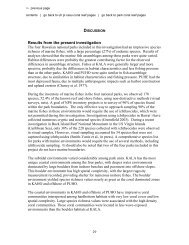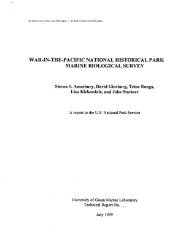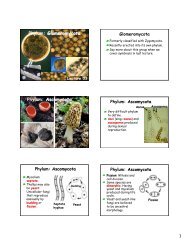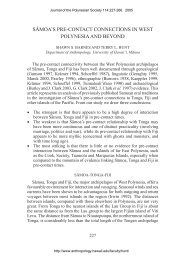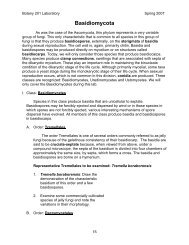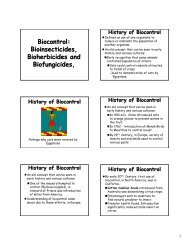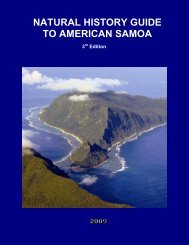american samoa - University of Hawaii at Manoa Botany Department
american samoa - University of Hawaii at Manoa Botany Department
american samoa - University of Hawaii at Manoa Botany Department
- No tags were found...
You also want an ePaper? Increase the reach of your titles
YUMPU automatically turns print PDFs into web optimized ePapers that Google loves.
Option 2: Construct Basaltic Wall, Stabilize East Stream Bank,and Enhance Riparian Veget<strong>at</strong>ionIn the vicinity <strong>of</strong> st<strong>at</strong>ion L6, a trench would be excav<strong>at</strong>ed along 300 linear feet <strong>of</strong> the drainagearea. The trench would be loc<strong>at</strong>ed immedi<strong>at</strong>ely west <strong>of</strong> existing residences on the east side <strong>of</strong>the Leafu Stream drainage (Figure 9-4).A basaltic rock wall would be constructed within the trench using wire gabions approxim<strong>at</strong>ely4x3x10-feet in size. Presence <strong>of</strong> the wall would better define the east stream bank and helpdirect future stream flows. At the same time, the wall may also help reduce potential flooddamage from medium stream flows. However, stream hardening along the east stream bankcould also gener<strong>at</strong>e an increase in stream flow velocities during stormw<strong>at</strong>er events.Some basaltic rock tre<strong>at</strong>ment would be made on the top and east side <strong>of</strong> the wall to ensure th<strong>at</strong>the wall would be <strong>at</strong>tractive and complement existing residential and subsistence agriculturaldevelopment. The wall would also be back-filled with n<strong>at</strong>ive soil on the east side <strong>of</strong> the wall toreduce the visual impact <strong>of</strong> the wire gabions (Figure 9-4).West <strong>of</strong> the proposed wall, the east stream bank would be enhanced through the planting <strong>of</strong>roughly 100 n<strong>at</strong>ive riparian trees such as ifi (Tahitian chestnut) fau, laufala, and falaga. Suchplants would increase the stability <strong>of</strong> the east stream bank th<strong>at</strong> adjoins residential properties.The propag<strong>at</strong>ion <strong>of</strong> seeds and/or collection <strong>of</strong> tree cuttings would be made by the ASCC LandGrant Program nursery and planted by Land Grant personnel in cooper<strong>at</strong>ion with locallandowners.Option 3: Stabilize East Stream Bank and Enhance Riparian Veget<strong>at</strong>ionOption 3 would be very similar to Option 2 except th<strong>at</strong> no basaltic wall would be constructed tobetter define the margin <strong>of</strong> the east stream bank near L6. Otherwise, the same type and number<strong>of</strong> n<strong>at</strong>ive riparian trees would be planted along portions <strong>of</strong> the east stream bank near L6 (Figure9-5).The establishment <strong>of</strong> ifi (Tahitian chestnut), fau, laufala, and falaga and other n<strong>at</strong>ive ripariantrees along the east stream would primarily help stabilize the east bank th<strong>at</strong> adjoins residentialand subsistence agricultural land uses. The root systems associ<strong>at</strong>ed with these trees containroots th<strong>at</strong> can effectively help stabilize the soil.The propag<strong>at</strong>ion <strong>of</strong> seeds and/or collection <strong>of</strong> tree cuttings would be made by the ASCC LandGrant Program nursery and planted by Land Grant personnel in cooper<strong>at</strong>ion with locallandowners. However, the ASCC Land Grant Program may elect to encourage adjoiningresidents to particip<strong>at</strong>e in the planting <strong>of</strong> these trees along the east stream bank.ASCC Land Grant has considerable experience with encouraging community particip<strong>at</strong>ionthrough its Forestry Stewardship Program. Colin Steele, ASCC/AHNR project forester,envisions th<strong>at</strong> the establishment <strong>of</strong> n<strong>at</strong>ive riparian trees and the rel<strong>at</strong>ed particip<strong>at</strong>ion <strong>of</strong> residentscan best be accomplished by providing, <strong>at</strong> no charge, a total <strong>of</strong> 30 tree seedlings to eachhousehold along the stream. However, the “no charge” arrangement would be conditional tothe resident’s agreement to plant the new trees within 30 feet <strong>of</strong> the stream bank (Steele, 1995).Consequently, some 100 riparian tree plantings would be randomly planted along the east bank,roughly 300-550 feet upstream <strong>of</strong> the stream mouth.American Samoa Wetlands/Streams Restor<strong>at</strong>ion and Enhancement PlanFebruary 2001, Leafu Stream, Page 9-11




